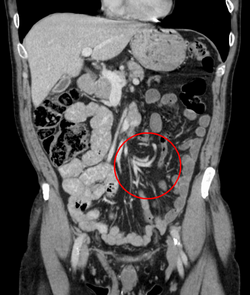Intestinal malrotation and volvulus
|
This article was marked by its author as Under construction, but the last edit is older than 30 days. If you want to edit this page, please try to contact its author first (you fill find him in the history). Watch the discussion as well. If the author will not continue in work, remove the template Last update: Monday, 02 Jan 2023 at 4.29 pm. |
Malrotation means a malfunction in the rotation of the intestine or a malfunction in its attachment to the back wall of the abdomen. A normal intestine rotates counterclockwise. The superior mesenteric artery acts as the axis of rotation. An unfixed bowel predisposes to volvulus (knotting of the bowel hinge) and obstruction. It is sometimes associated with asplenism or congenital heart defects.
Clinical picture
- Symptoms of acute or recurrent NPB appear,
- symptoms are developed shortly after birth or anytime during the first year of life.
Diagnosis
- On the X-ray, we can see the distribution of air - there are no bubbles in the area of the caecum,
- rotation failure is then confirmed by irrigography.
Therapy
- Surgical.
Links
Related articles
- Congenital atresias and stenoses of the gastrointestinal tract
- pylorostenosis congenita
- superior mesenteric artery syndrome
- small bowel obstruction
- meconium ileus
- megacolon congenitum
Source
- BENEŠ, Jiří. Studijní materiály [online]. ©2007. [cit. 2010-04]. <http://www.jirben.wz.cz/>.
References
- HRODEK, Otto – VAVŘINEC, Jan. Pediatrie. 1. edition. Galén, 2002. ISBN 80-7262-178-5.
- ŠAŠINKA, Miroslav – ŠAGÁT, Tibor – KOVÁCS, László. Pediatria. 2. edition. 2007. ISBN 978-80-89171-49-1.



